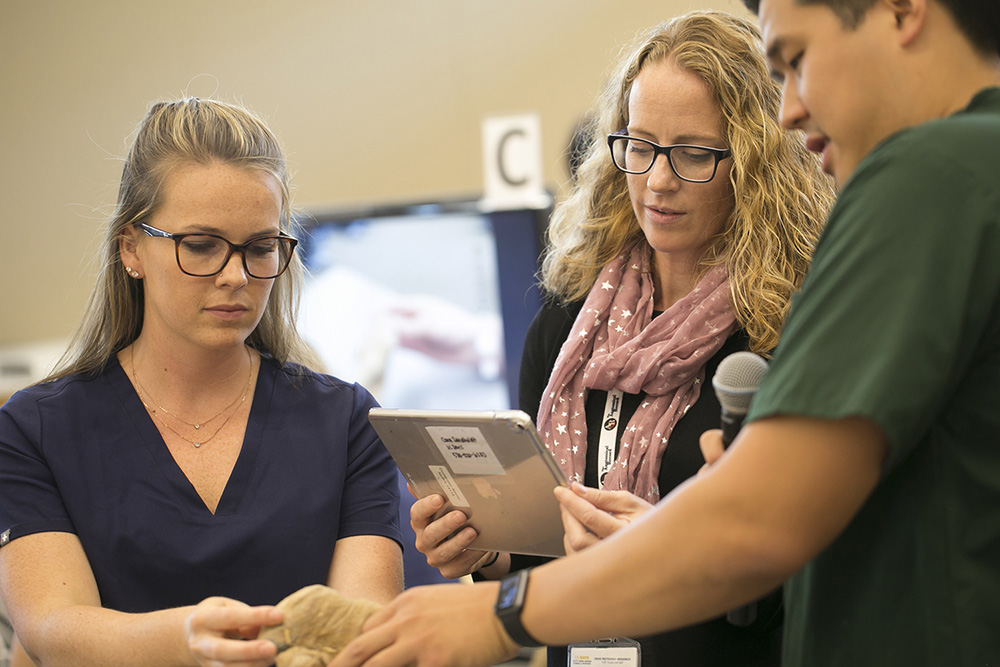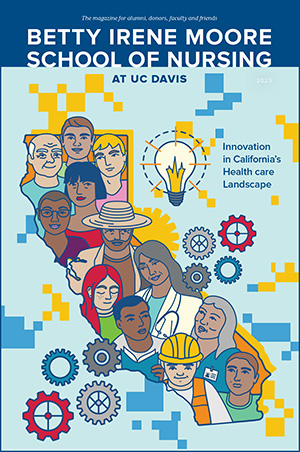Curriculum shifts in health care education

Assistant Professor Cara Sandholdt guides two students through a course module on organ systems.
How today’s landscape requires a concept-based approach
To say the landscape of health care constantly changes is to state the obvious.
- People are living longer and battling more and increasingly complex conditions.
- Providers spend fewer minutes in a visit and see more patients each day.
- Technology’s role is growing in how and where people interact with their health care team.
With health care knowledge doubling every 73 days, memorizing body systems and disease facts are not enough. Higher-order thinking is required so that what students learn translates into the ever-changing real world.
“Shifting from a systems-based to a concept-based curriculum develops students’ problem-solving skills so they can transfer that knowledge into a variety of situations.”
“The exponential generation of knowledge and information in all areas of our world makes it literally impossible to know all the information within a discipline,” said Kathryn Sexson, director for the Doctor of Nursing Practice — Family Nurse Practitioner (D.N.P.-F.N.P.) Degree Program at the Betty Irene Moore School of Nursing at UC Davis.
Concept -based curriculum offers an integrated way of putting classroom content into big ideas. Based on a solid set of concepts and sub-concepts, School of Nursing D.N.P-F.N.P. students progress through their clinical year with a deeper understanding of patient health, rather than narrowing in a specific disease.
For example, students will learn inflammation starting in pathophysiology, with understanding the physiologic and psychologic processes. As they progress into pharmacology and health assessment, they will see how to diagnose and treat inflammation, deciding the best methods for assessment and prescription recommendations. Finally, in the clinical courses, students will build on that foundation and participate in case-based learning with specific exemplars of diseases that manifest with inflammation and how acute, chronic and complex conditions require different clinical management.
Faculty making the switch argue it’s a natural way of learning.
“When we teach body systems, for example, how to assess a heart problem, what to test for, how to diagnose and treat, we go one system at a time. The way they all work together is an afterthought. It’s up to the student to put that together. It blocks things in an unnatural way,” explained Cara Sandholdt, an assistant professor who teaches anatomy, physiology and pathophysiology.
While the move make sense, Sandholdt said it isn’t necessarily easy.
“We have to daily remind ourselves that we have shifted,” Sandholdt said. “After teaching a systems-base curriculum for 15 years, it’s challenging to switch your mode of thinking.”
Sexson said the change may also be noticeable for advanced nursing students, who remember their early nursing education was systems based. Many nursing schools, she said, are working to update their curriculum in step with newly updated core competencies by the American Association of Colleges of Nursing (AACN).
“Our concept-based curriculum is the UC Davis approach to achieving the AACN competency-based essentials,” she said.
Because this approach integrates the concepts, students can use logic to see the bigger picture, which is the goal of education for an advanced degree, such as the D.N.P.
In the new School of Nursing program, concept-based curriculum begins on the very first day of instruction. That prepares students to think holistically rather than just narrowing on a singular focus — an organ or system — to build their diagnosis.
“Our patients don’t come with boxes around their hearts and lungs. They present as an integrated complex person,” Sandholdt said. “When we can put that together with processes and concepts in a more holistic way, we can understand a patient’s needs and treat them with a more well-rounded view.”
Graduates of the new D.N.P.-F.N.P. program benefit from this approach first in how it builds the clinical skills needed to deliver evidence-based care. In addition, it also primes them to improve the current systems of care by understanding how those apply to the health of entire populations.
So how does that look for a student? Take, for example, the Patient and Population Health Course. Students learn about discriminatory practices, such as redlining, and how those policies exposed certain populations to a variety of pollutants that affect their respiratory health. Combining that knowledge with the physiologic and psychologic processes, a student can assess the proper care plan that takes into consideration environmental factors.
“Our curriculum is based on three large concept groupings: health care recipient, health and illness, and professional nursing and health care,” Sexson said. “Our ultimate goal is to prepare excellent clinicians who can improve population health, enhance patient experience, lower cost and advance health equity.”
There’s emerging evidence that also suggests the approach bridges the gaps between learners from disadvantaged backgrounds.
“Sometimes when we teach things in boxes, we expect students to make metacognitive links between concepts,” Sandholdt said. “There is evidence that working with students from a concept-based perspective helps them make connections that, before, were more challenging to make.”





